HIGHER DIETARY ZINC INTAKE IS ASSOCIATED WITH a nearly one-third lower chance of migraine headaches, according to a new study of more than 11,000 American adults. Zinc fights migraines.
“Presiding over the entire attack there will be, in du Bois Reymond’s words, “a general feeling of disorder,” which may be experienced in either physical or emotional terms, and tax or elude the patient’s powers of description.”
― Oliver Sacks, Migraine
Headache disorders are common
According to the Global Burden of Disease (GBD) study, headache disorders are among the most prevalent and disabling conditions worldwide. Migraine is second among the world’s causes of disability and first among young women.

There is geographic variation. For example, headache disorders are the third leading cause of years lost due to disability in East Asia, the Middle East, and northern Africa. Headaches rank number two in Europe and Central Asia, fourth in South Asia and sub-Saharan Africa, fifth in Latin America and the Caribbean, and sixth in North America.
Looking at income level and years lost due to disability, headache disorders are third in countries classed by the World Bank as lower- or upper-middle-income but fourth in low-income countries and fifth in those classed as high-income.
Zinc fights migraines: Zinc basics.
Zinc is a mineral that is throughout your body. The mineral helps your immune system and metabolic function. We use zinc for wound healing and taste and smell sense.
The Mayo Clinic (USA) offers that most of us can get sufficient zinc through diet. Food sources include red meat, chicken, and fortified breakfast cereals.
While some individuals use zinc to help treat the common cold (it needs to be taken within 24 hours of the first symptoms), it can diminish the effectiveness of certain medications and can be associated with side effects.
Individuals with skin ulcers and low zinc levels might benefit from oral zinc supplements. Finally, oral zinc might slow the progression of age-related macular degeneration.
The recommended daily amount (RDA) of zinc is 11 mg for men and 8 milligrams (mg) for women.
Some plant foods, such as legumes and whole grains, are good sources of zinc but contain phytates that can bind to the mineral, lowering its absorption. Here are some examples of zinc-containing foods:
- Oysters, crab, and lobster
- Beef
- Poultry
- Pork
- Legumes
- Seeds and nuts
- Whole grains
- Fortified breakfast cereals
Zinc fights migraines: A new study
Those with a higher dietary zinc intake have a nearly one-third lower probability of migraine headaches than those with little zinc.
For their research, investigators analyzed publicly available data from the U.S. National Health and Nutrition Examination Survey to determine whether people self-reporting migraines or severe headaches reported lower zinc intake than those without migraines. Researchers used data from 1999 and 2004, including information on food and beverage consumption in 24 hours (and other health information).
The study authors divided the 11,088 subjects (with an average age of 46.5 years and equal numbers of males and females) into quintiles based on dietary zinc consumption through foods and supplements.
Twenty percent of the cohort reported migraine or severe headaches within the previous three months.
The results are striking, with Dr. Liu and colleagues reporting the following:
There was an inverse association between dietary zinc consumption and migraine, with the highest-consuming quintile of the cohort (15.8 mg or more zinc per day) seeing the lowest migraine risk (30 percent relative decrease)), compared with the low-consuming quintile (5.9 mg or less daily).
For those getting high levels of zinc (19.3–32.5 mg daily) through supplements, the migraine risk appeared 38 percent lower.
The investigators acknowledge some study limitations, including its cross-sectional design. Also, researchers used a broad question to determine the prevalence of migraine headaches.
Zinc is associated with migraine frequency, perhaps through its anti-inflammatory and antioxidant properties.
My take: Zinc fights migraines
Oral zinc supplements appear to help those with low levels of zinc. Taken immediately after a cold, it may shorten the common cold length. Zinc may also help with wound healing and migraine headaches.

However, don’t use intranasal (through the nose) zinc, as it has been linked with smell loss. Oral zinc may result in indigestion, diarrhea, headache, nausea, or vomiting. Long-term use (or in high doses) may cause neurological problems such as an arm or leg numbness or weakness.
The National Institutes of Health regards 40 mg of zinc daily as the upper limit dose for adults and 4 mg for infants under six months. Don’t use intranasal zinc. This form of zinc has been linked with the loss of the sense of smell.
Finally, zinc can interfere with the performance of some antibiotics, including quinolones or tetracyclines. Taking the antibiotic two hours before (or four to six hours after) taking zinc may help reduce this effect.
Thiazide diuretics can increase the loss of zinc through the urine. Zinc can also reduce the effectiveness of the rheumatoid arthritis drug penicillamine (Depen; Cuprimine). Taking the antibiotic two hours before (or four to six hours after) taking zinc may help reduce this effect.
Want more zinc? Eat a healthy, balanced diet. Most of us get enough zinc in our diet; vegetarians, vegans, pregnant or breastfeeding women, and adults over age 65 may need supplemental zinc.
The information I provided in this blog is for educational purposes only and does not substitute for professional medical advice. Please consult a medical professional or healthcare provider if you seek medical advice, diagnoses, or treatment. I am not liable for risks or issues associated with using or acting upon the information in this blog.
Thank you for joining me in this look at how zinc may fight migraines.

























